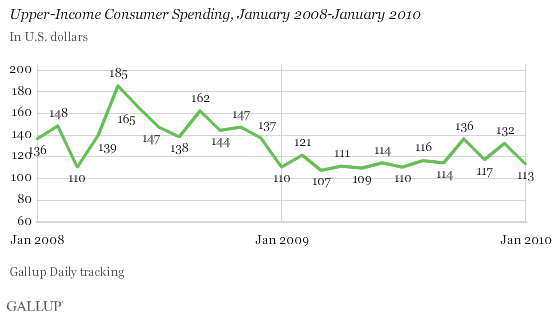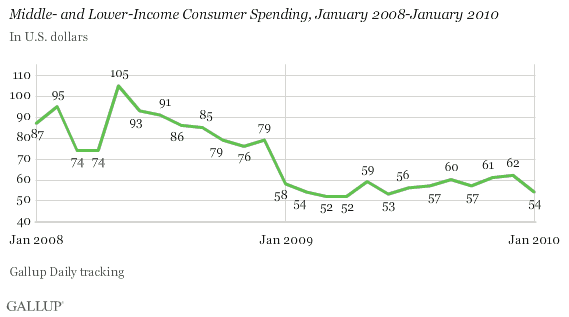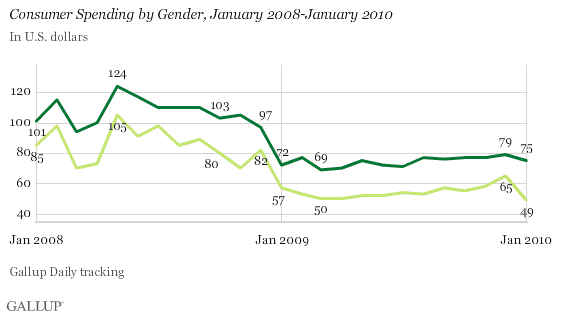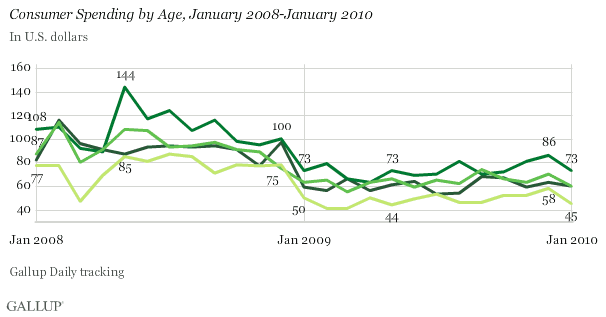PRINCETON, NJ -- Contrary to the impression given by some recent government reports, Americans' self-reported spending declined in January 2010 compared with December, returning to the seeming "new normal" levels of 2009. Americans in upper-income households (those making $90,000 or more a year) reported spending an average of $113 per day in stores, restaurants, gas stations, and online in January -- down 14% from December's $132, and essentially matching their $110 average of a year ago.

Middle- and lower-income Americans (those making less than $90,000 a year) likewise reported 13% less spending in January ($54 per day) than in December ($62), and slightly less than in January 2009 ($58).

Upper-income Americans' spending in January returned to the relatively tight range ($107-$121) that, with the exceptions of October and December, characterized this group in 2009. Since upper-income households by definition have more disposable income and, thus, tend to do more discretionary spending than other Americans, this return to the 2009 range likely represents a resumption of the "new normal" spending patterns. The slight decline in middle- and lower-income spending confirms this.
Women's Self-Reported Spending Falls Sharply
Average self-reported spending among women was $49 per day in January 2010 -- down 25% from December and 14% from January 2009. In sharp contrast, men spent an average of $75 per day in January -- $4 less than in December and $3 more than a year ago.

Year-Over-Year Self-Reported Spending Down in All Regions but the South
Consumer spending declined in all regions compared with December: in the East, it was down 18%; in the West, 16%; in the Midwest, 13%; and in the South, 11%. Year-over-year spending declined in all regions except the South, where it increased by 8%. The greatest decline was in the West (-13%), followed by the Midwest (-7%) and the East (-6%). The South's improvement and the West's deterioration are consistent with the .

Youngest Reduce Spending the Least; Oldest, the Most
Month-to-month consumer spending fell across all age groups in January, with the decline greatest among older Americans (-22%) and least among young adults (-5%). Spending across all age groups was essentially unchanged in January 2010 compared with January 2009.

Spending New Normal
Probably the most stunning aspect of January's self-reported spending results is the way spending among upper-income Americans returned to the 2009 new-normal spending range. Evidently these Americans decided to use their discretionary income during the holidays, but pulled back once more in early 2010. Older Americans and women show a similar pattern, increasing their spending in December and pulling back once more in January 2010.
shows a similar pattern. Year-over-year comparisons show consumer spending returning to the new-normal range of last year.
Wednesday's one-year anniversary of the president's signing the federal stimulus plan into law has given politicians and economists an opportunity to debate the legislation's effectiveness at bolstering the economy and creating jobs. While this debate may be of great importance politically, it has little real meaning for the lives of most Americans.
Instead, policymakers would seem to be better off focusing on what they need to do to get women, and upper-income and older Americans more comfortable about spending. Regional spending results may suggest part of the answer: year-to-year spending is up in the South, where job conditions are best, and down the most in the West, where job conditions are worst. Creating private-sector jobs is essential to getting consumers to increase spending.
However, Gallup's spending data also suggest another important consideration: the spending new normal. After the financial crisis and recession of the past couple of years, many upper-income and older Americans, as well as women in general, may no longer feel as secure or comfortable in spending as they have in the past. They seem to want to reduce their debt and strengthen their household balance sheets.
On the one hand, this suggests that policymakers may want to think about how they can increase the financial comfort of Americans in general and these groups in particular. On the other hand, all Americans and the businesses that serve them may want to think about how best to adjust to the current spending new normal in case it persists for some time to come.
Review and export the complete daily trends on these measures: ; ; ; ;
Survey Methods
For ÆéûÜǨû§Daily tracking, ÆéûÜǨû§interviews approximately 1,000 national adults, aged 18 and older, each day. The ÆéûÜǨû§consumer spending results are based on random half-samples of approximately 500 national adults, aged 18 and older, each day. Results for January are based on telephone interviews with more than 14,000 adults. For these results, one can say with 95% confidence that the maximum margin of sampling error is ôÝ1 percentage points. Results for the various breakout reported here are based on interviews with more than 1,000 respondents with a maximum margin of error of ôÝ3 percentage points.
Interviews are conducted with respondents on land-line telephones and cellular phones.
In addition to sampling error, question wording and practical difficulties in conducting surveys can introduce error or bias into the findings of public opinion polls.
